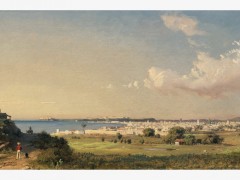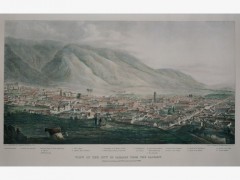Boundless Reality: Traveler artists’ landscapes of Latin America from The Patricia Phelps De Cisneros Collection
30.10/2016 – 23.01/2016
Americas Society & Hunter College, New-York
Boundless Reality serves as an introduction to the genre of Latin American traveler art of the 17th to 19th century. It addresses the importance of this art in its moment and unfolds the rich histories that surround the individual artists and artworks.
This genre, which is only recently attracting a wider interest, begins with the curiosity that accompanied European imperialism. Alexander von Humboldt’s reflections on the aesthetics of landscape observation were appropriated by a new generation of travelers. These early 19th century travelers illustrated narratives of exploration in the New World, which were published and widely sought after in Europe, signaling the emergence of a new figure—the traveler artist.
The paintings and drawings produced during these adventures document the ways in which travelers encountered and experienced the region, and they influenced the ways in which Europeans have understood tropical nature and culture. At the time, Europeans imagined the tropics as a site for cultural imperialism and fantasies of self-realization. Traveler artists often authenticated this perception by presenting the landscape as an enchanted land.
In the middle of the 19th century, North American artists from the Hudson River School began to venture into the genre of South American landscapes. Frederic Edwin Church aspired to retrace Humboldt’s itinerary in order to redraw his views with new techniques and a new spirit.
Nearing the end of the period, native born artists were picking up the European landscape tradition and reflecting on their own culture and landscape through a different lens. José Maria Velasco’s paintings of Mexico not only demonstrate an adaption of the European enlightenment sensibility, but also illustrate the growing sense of national identity observed in the country at the time.
The significance of these images in the process of producing knowledge about these places indicates the range of approaches these artists had in considering their subjects. Some from a scientific perspective, others a quasi-religious zeal, all reflecting the major concerns of the 19th century mind as it was faced with this new and intriguing landscape.
Boundless Reality is the culmination of a multi-year collaborative effort between Hunter College, The Graduate Center at CUNY, Americas Society, and the Colección Patricia Phelps de Cisneros (CPPC). The exhibition’s conceptual framework was established through the seminar Imagining the Latin American Landscape: The Nineteenth-Century Gaze, a curatorial practicum for MA and MFA students at Hunter College. During this seminar, taught by the exhibition’s curator Professor Harper Montgomery, the students studied the artworks in person, produced original research on their assigned works, and collectively conceived of the exhibition’s narrative and checklist.
The exhibition includes major works by key figures in the genre of Latin American traveler art: Frans Post’s View of Frederica City in Paraiba (1638) and his Landscape with Chapel (c. 1663); Cotopaxi (1853) by Frederick Edwin Church, and Sunset: A Scene in Brazil (1864-65) by Martin Johnson Heade, as well as Fritz George Melbye’s views of Jamaica and Venezuela (1866, 1853) and José Maria Velasco’s views of Mexico (1870s). Additionally, works from the CPPC’s complete holdings of photographs and drawings from Auguste Morisot’s 1886 expedition up the Orinoco River allowed for the consideration of questions related to the emergence of photography in the nineteenth-century and its relationship to the conventions of painting and drawing the exotic landscape.
This post is also available in: Spanish

 Home
Home

